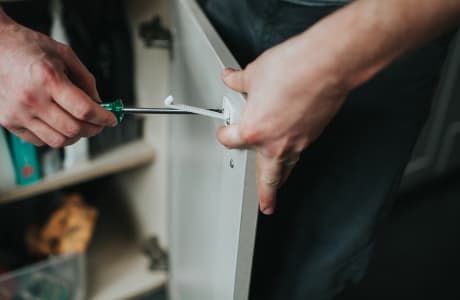Our Health Library information does not replace the advice of a doctor. Please be advised that this information is made available to assist our patients to learn more about their health. Our providers may not see and/or treat all topics found herein. To a baby's eyes, your home is one big playground. They see a lot of things to crawl under, climb on top of, pull down, touch, taste, and smell. It can be fun to watch your baby discover new things as your baby learns to crawl and walk. But it can also be scary to think about what your baby might get into around the house. You can't watch your baby's every move. But you can take steps to help keep your baby safe and still let your baby explore. You can't watch your baby's every move. But there are steps you can take to help keep your little one safe. Check safety standards for things like cribs, strollers, playpens, high chairs, and changing tables. Go to the CPSC's website at www.cpsc.gov to learn more. Examples are bookshelves, dressers, TVs, and other objects that might tip. Don't use accordion-style gates, because your baby's head could get caught. Attach cords to mounts that hold them tight, and wrap them around wall brackets. Cut open any loops in cords for drapes or blinds. It only takes a moment for a pet to hurt your baby. If this isn't possible, unload all guns, keep them locked up, and store bullets in a place away from the guns. Here are some steps you can take to help keep your baby safe around water. Always keep your baby within arm's reach. And never leave an older child in charge of watching your baby, even if the older child is in the room or in the tub with your baby. You can use toilet seat locks to keep the lid closed. And turn them over when they aren't in use. Use pool covers that lock. Here are some ways to help keep your baby safe from toxic substances in the home. If your child is exposed to lead, they might develop health problems and have trouble learning. Go to the U.S. Consumer Product Safety Commission (CPSC) website at www.cpsc.gov to learn more. House paint is no longer made with lead. But older homes may still have it. Babies often like to eat paint chips or chew on painted surfaces. Even a small amount of lead can harm your baby. If you know that paint has lead in it, don't remove it yourself. When crushed or broken down, lead paint may contaminate dust and dirt in the surroundings. Have it removed by a professional with experience in lead hazard control. This includes cleaners and other chemicals, medicines, makeup, perfumes, and other products that can harm your baby if they eat or smell them. Be aware that everyday items, such as mouthwash and some plants, can harm your baby. Here are some ways you can help protect your baby from choking. For example, a baby who is choking can't cry, breathe, or cough. Take a class on the Heimlich maneuver and CPR so you'll know what to do if your baby chokes. Your baby could choke if the fluid "goes down the wrong way" and gets into the lungs. Here are some ways you can help keep your baby safe from suffocation. And remove any pillows, toys, and stuffed animals from the crib. They can cover your baby's face and make it hard for your baby to breathe. Don't use crib bumpers, sleep positioners, or head-shaping pillows. Your baby could be smothered and be at a higher risk for SIDS. Keep them out of reach. If you are storing an old refrigerator or freezer, remove the door. Dogs, cats, and other animals can smother your baby. Try these tips to help keep your baby safe from burns. This can help prevent burns from hot water. Hot spots in the liquid can burn your baby's mouth and throat. Unplug items such as coffee pots, toasters, fans, and lamps. Secure fireplace screens so your baby can't knock them over or get around them. Current as of: October 24, 2024 Author: Ignite Healthwise, LLC Staff Current as of: October 24, 2024 Author: Ignite Healthwise, LLC Staff Clinical Review Board This information does not replace the advice of a doctor. Ignite Healthwise, LLC disclaims any warranty or liability for your use of this information. Your use of this information means that you agree to the Terms of Use and Privacy Policy. Learn how we develop our content. To learn more about Ignite Healthwise, LLC, visit webmdignite.com. © 2024-2025 Ignite Healthwise, LLC.Topic Contents
Quick Tips: Babyproofing Your Home
Get started

To prevent injury
To prevent drowning
To prevent poisoning
To prevent choking
To prevent suffocation
To prevent burns
Related Information
Credits
Clinical Review Board
All Ignite Healthwise, LLC education is reviewed by a team that includes physicians, nurses, advanced practitioners, registered dieticians, and other healthcare professionals.
All Ignite Healthwise, LLC education is reviewed by a team that includes physicians, nurses, advanced practitioners, registered dieticians, and other healthcare professionals.
Our Health Library information does not replace the advice of a doctor. Please be advised that this information is made available to assist our patients to learn more about their health. Our providers may not see and/or treat all topics found herein. Current as of: October 24, 2024 Author: Ignite Healthwise, LLC Staff Clinical Review BoardQuick Tips: Babyproofing Your Home
All Ignite Healthwise, LLC education is reviewed by a team that includes physicians, nurses, advanced practitioners, registered dieticians, and other healthcare professionals.



